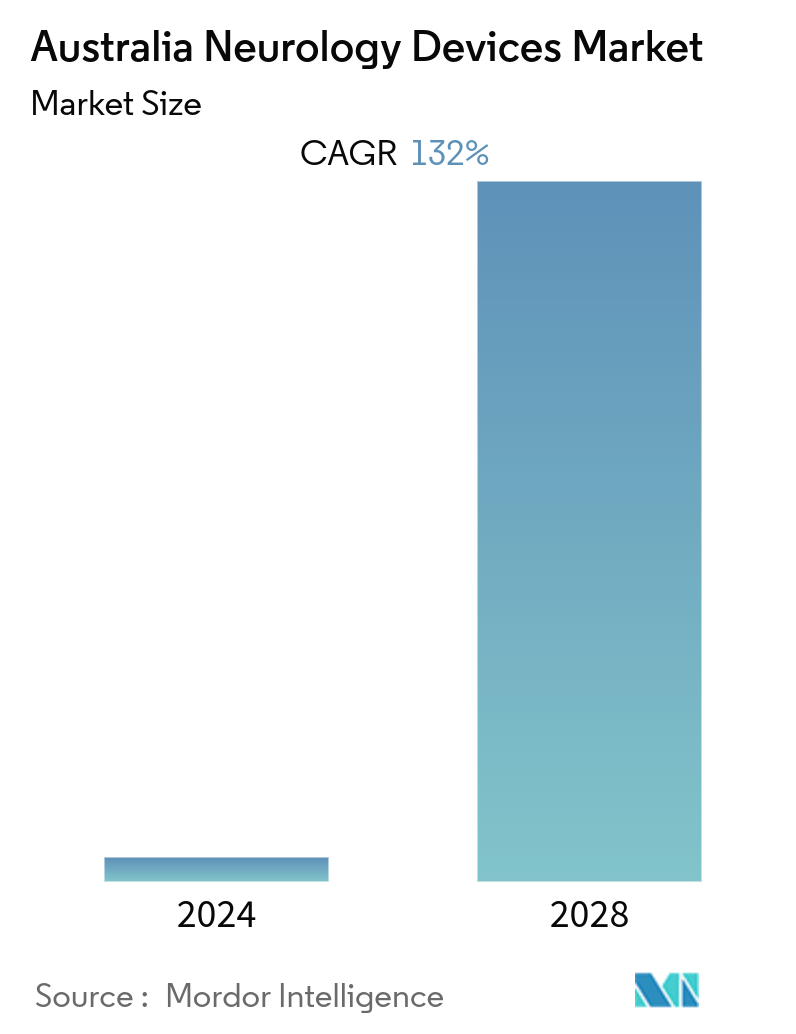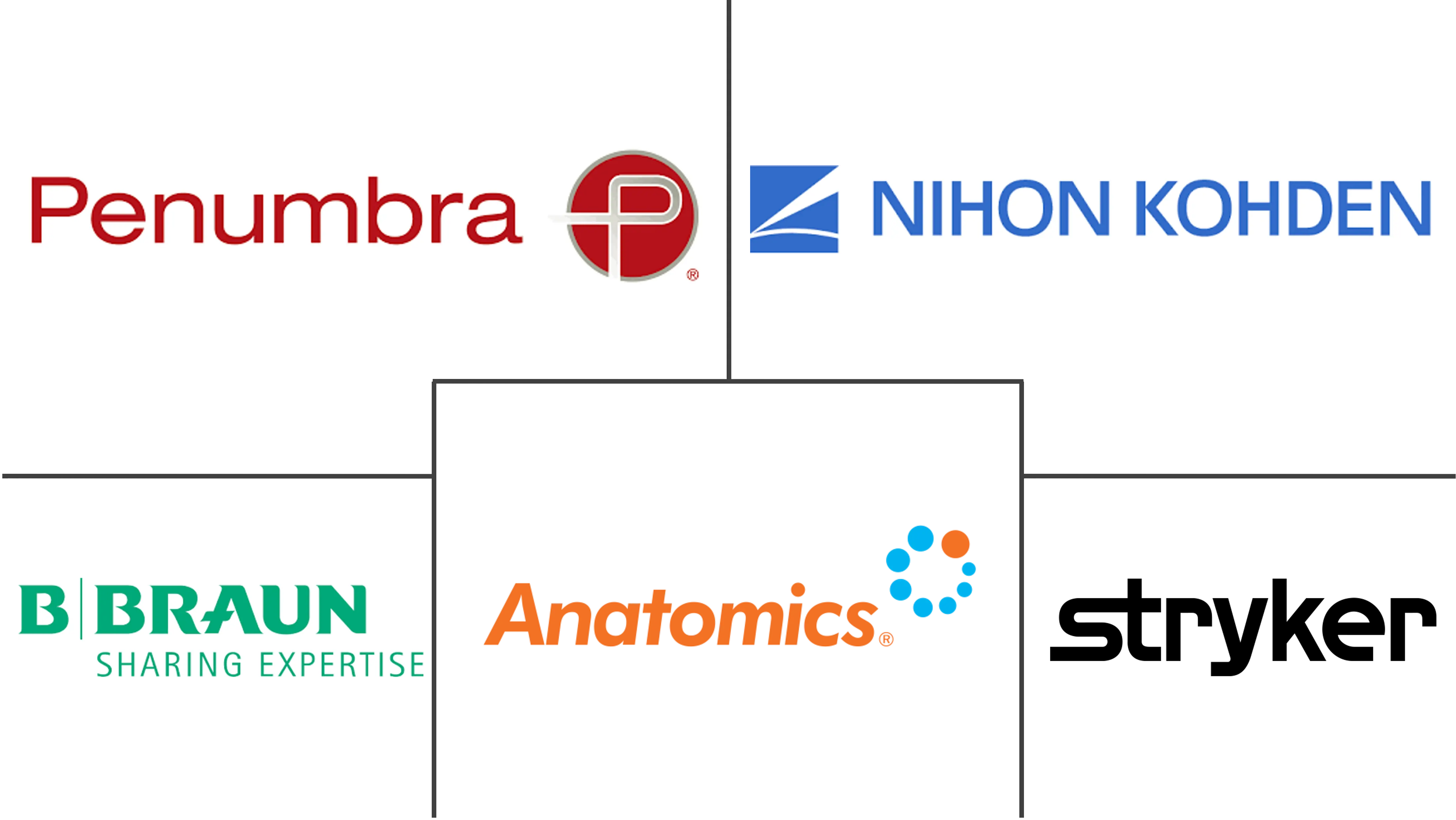Market Size of Australia Neurology Devices Industry

| Study Period | 2019 - 2027 |
| Base Year For Estimation | 2021 |
| CAGR (2024 - 2028) | 132.00 % |
| Fastest Growing Market | Africa |
| Largest Market | Asia |
| Market Concentration | Low |
Major Players
*Disclaimer: Major Players sorted in no particular order |
Australia Neurology Devices Market Analysis
The Australia Neurology Devices Market is expected to register a CAGR of 132% during the forecast period.
COVID-19 had a significant impact on the Australia neurology devices market. For instance, as per the article published in October 2021 under the title “Tele-Neurorehabilitation During the COVID-19 Pandemic: Implications for Practice in Low- and Middle-Income Countries”, countries like Australia and the United Kingdom, advocate for the development of highly competent inter-professional rehabilitation services, as well as frameworks or recommendations to improve the provision of physiotherapy treatments remotely via technology during COVID-19. Furthermore, as per the case report published in September 2020 under the title “First Australian Case of Good Recovery of a COVID-19 Patient With Severe Neurological Symptoms Post Prolonged Hospitalization”, recovery of a COVID-19 patient was complicated by significant neurological symptoms (acute ischemic stroke-like symptoms) during a 26-day prolonged intensive care unit stay, followed by gradual neurorehabilitation and normal recovery from both respiratory and neurological involvement. Hence, owing to the factors mentioned above, COVID-19 had a significant impact on the Australia neurology devices market.
Furthermore, an increase in the incidence of neurological disorders coupled with rising in the geriatric population, and an increase in research and development in the field of neurotherapy fuel the market growth in Australia. For instance, the number of people with dementia rises quickly with age. As per the 'Dementia in Australia' 2022 update, in 2022, there are 487,500 Australians living with dementia. Without a medical breakthrough, the number of people with dementia is expected to increase to almost 1.1 million by 2058. Hence, the increased neurological disease such as dementia is likely to boost the market growth over the forecast period.
Furthermore, government initiatives and product launch regarding neurology is also contributing to the market growth. For instance, as per the University of Queensland news 2021 report, Queensland Brain Institute (QBI), together with Neurosciences Queensland and Abbott Neuromodulation developed a remote care platform that allows patients to access treatment from anywhere in the world. This digital health platform for remote neuromodulation systems has regulatory approval and was launched in Australia in October 2021.
Hence, considering the factors mentioned above, Australia neurology devices market is likely to witness growth over the forecast period. However, the high cost of equipment and stringent regulations restrain the market growth.
Australia Neurology Devices Industry Segmentation
As per the scope of the report, neurological devices are medical devices that help to diagnose, prevent, and treat a variety of neurological disorders and conditions, such as Alzheimer's disease, Parkinson’s disease, major depression, and traumatic brain injury. The Australia Neurology Devices Market is segmented by Type of Device (Cerebrospinal Fluid Management Devices, Interventional Neurology Devices, Neurosurgery Devices, Neurostimulation Devices, and Other Types of Devices). The report offers the value (in USD million) for the above segments.
| By Type of Device | |
| Cerebrospinal Fluid Management Devices | |
| Interventional Neurology Devices | |
| Neurosurgery Devices | |
| Neurostimulation Devices | |
| Other Types of Devices |
Australia Neurology Devices Market Size Summary
The Australia neurology devices market is poised for significant growth, driven by an increasing incidence of neurological disorders and a rising geriatric population. The market is experiencing a surge in research and development within the neurotherapy sector, which is further bolstered by government initiatives and product launches. The COVID-19 pandemic has also played a pivotal role in shaping the market, as it highlighted the need for advanced inter-professional rehabilitation services and remote physiotherapy treatments. This has led to the development of innovative digital health platforms, such as the one launched by the Queensland Brain Institute in collaboration with Abbott Neuromodulation, which allows for remote neuromodulation treatments. Despite the promising growth prospects, the market faces challenges due to the high cost of equipment and stringent regulatory requirements.
The neurostimulation devices segment is expected to witness substantial growth, fueled by the increasing adoption of sacral nerve stimulation and deep brain stimulation devices. The high prevalence of neurological diseases, such as dementia and Alzheimer's, is driving the demand for these devices, as they offer potential relief and improved quality of life for patients. The market is characterized by moderate competition, with major players like Stryker Corporation, B. Braun Melsungen AG, and Nihon Kohden Corporation actively engaging in agreements, collaborations, and product development to strengthen their market presence. Recent product launches, such as Mainstay Medical's ReActiv8 system for chronic low back pain, further underscore the dynamic nature of the market. Overall, the Australia neurology devices market is set to expand, supported by technological advancements and strategic industry collaborations.
Australia Neurology Devices Market Size - Table of Contents
-
1. MARKET DYNAMICS
-
1.1 Market Overview
-
1.2 Market Drivers
-
1.2.1 Increase in Incidence of Neurological Disorders coupled with Rise in Geriatric Population
-
1.2.2 Increase in R&D in the Field of Neurotherapies
-
-
1.3 Market Restraints
-
1.3.1 High Cost of Equipment and Stringent Regulations
-
-
1.4 Porter's Five Force Analysis
-
1.4.1 Threat of New Entrants
-
1.4.2 Bargaining Power of Buyers/Consumers
-
1.4.3 Bargaining Power of Suppliers
-
1.4.4 Threat of Substitute Products
-
1.4.5 Intensity of Competitive Rivalry
-
-
-
2. MARKET SEGMENTATION (Market Size by Value - USD Million)
-
2.1 By Type of Device
-
2.1.1 Cerebrospinal Fluid Management Devices
-
2.1.2 Interventional Neurology Devices
-
2.1.3 Neurosurgery Devices
-
2.1.4 Neurostimulation Devices
-
2.1.5 Other Types of Devices
-
-
Australia Neurology Devices Market Size FAQs
Who are the key players in India Automotive Lubricants Market
Bharat Petroleum Corporation Limited, BP PLC (Castrol), Gulf Oil International, Hindustan Petroleum Corporation Limited and Indian Oil Corporation Limited are the major companies operating in the India Automotive Lubricants Market.
Which is the fastest growing region in India Automotive Lubricants Market?
Commercial Vehicles is estimated to grow at the highest CAGR over the forecast period (2021-2026).

